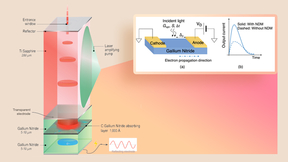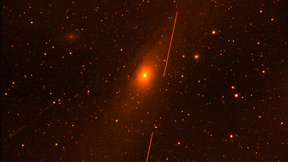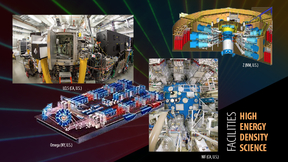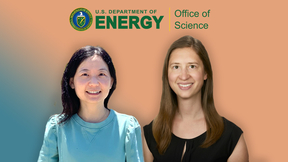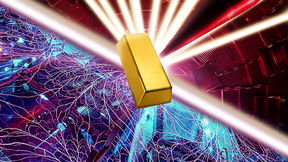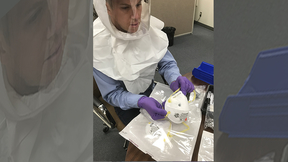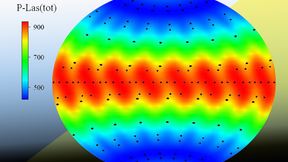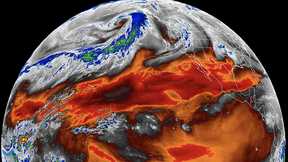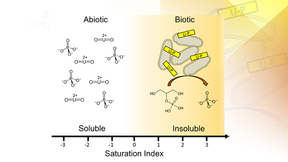Back
Science
Lawrence Livermore team designs semiconductor switch for next-generation communications
Lawrence Livermore National Laboratory (LLNL) engineers have designed a new kind of laser-driven semiconductor switch that can theoretically achieve higher speeds at higher voltages than existing photoconductive devices. The development of such a device could enable next-generation satellite communication systems capable of transferring more data at a faster rate, and over…
LLNL/Tyvak space telescope goes into orbit
Thousands of images of Earth and space have been taken by a compact space imaging payload developed by Lawrence Livermore National Laboratory (LLNL) researchers and its collaborator Tyvak Nano-Satellite Systems. Known as GEOStare2, the payload has two space telescopes that together have taken more than 4,500 pictures for space domain awareness, astronomy and Earth…
Research highlights techniques for studying materials under extreme conditions
The properties of materials under extreme conditions are of key interest to a number of fields, including planetary geophysics, materials science and inertial confinement fusion (ICF). In geophysics, the equation of state of planetary materials such as hydrogen and iron under ultrahigh pressure and density will provide a better understanding of their formation and interior…
From NIF to Z: LLNL continues to collaborate with Sandia on technology transfer projects
Lawrence Livermore National Laboratory (LLNL) and Sandia National Laboratories continue to collaborate on diagnostic advancements on the nation’s premier high-energy density (HED) facilities. Mark Bowers, magnetic direct drive diagnostics manager at the National Ignition Facility (NIF), said current projects include providing NIF’s X-ray streak camera, neutron Time-of…
DOE honors Schmidt and Zheng, two early career Lab scientists
Two scientists from Lawrence Livermore National Laboratory (LLNL) are recipients of the 2021 Department of Energy’s (DOE) Office of Science Early Career Research Program award. Andrea Schmidt and Xue Zheng are among 83 scientists nationwide selected for the recognition. Under the program, typical awards for DOE national laboratory staff are $500,000 per year for five years…
Smashing gold with finesse: Shockless compression experiments establish new pressure scales
To test the Standard Model of particle physics, scientists often collide particles using gigantic underground rings. In a similar fashion, high-pressure physicists compress materials to ever greater pressures to further test the quantum theory of condensed matter and challenge predictions made using the most powerful computers. Pressures exceeding 1 million atmospheres are…
Decontaminating N95 masks for reuse
Scientists at Lawrence Livermore National Laboratory (LLNL) have determined that heating N95 respirators up to 75 degrees Celsius for 30 minutes deactivates a surrogate coronavirus without compromising the device’s fit and its ability to filter airborne particles. This temperature (equivalent to 167 degrees Fahrenheit) is easily achieved in hospitals and field settings…
Scientists use simulations to examine the performance of materials in NIF experiments
Scientists have examined the performance of pure boron, boron carbide, high-density carbon and boron nitride ablators — the material that surrounds a fusion fuel and couples with the laser or hohlraum radiation in an experiment — in the polar direct drive exploding pusher (PDXP) platform, which is used at the National Ignition Facility (NIF). The platform uses the polar…
Experiments validate the possibility of helium rain inside Jupiter and Saturn
Nearly 40 years ago, scientists first predicted the existence of helium rain inside planets composed primarily of hydrogen and helium, such as Jupiter and Saturn. However, achieving the experimental conditions necessary to validate this hypothesis hasn’t been possible — until now. In a paper published today by Nature, scientists reveal experimental evidence to support this…
Laser-driven ion acceleration with deep learning
While advances in machine learning over the past decade have made significant impacts in applications such as image classification, natural language processing and pattern recognition, scientific endeavors have only just begun to leverage this technology. This is most notable in processing large quantities of data from experiments. Research conducted at Lawrence Livermore…
Satellites may have underestimated warming in the lower atmosphere
New research by Lawrence Livermore National Laboratory (LLNL) climate scientists and collaborators shows that satellite measurements of the temperature of the troposphere (the lowest region of the atmosphere) may have underestimated global warming over the last 40 years. The research appears in the Journal of Climate. The team studied four different properties of tropical…
Observations show marine clouds amplify warming
A new analysis of satellite cloud observations finds that global warming causes low-level clouds over the oceans to decrease, leading to further warming. The work, led by researchers at Lawrence Livermore National Laboratory (LLNL), in collaboration with colleagues from Scripps Institution of Oceanography and the NASA Langley Research Center, appears online in Nature…
Lab’s Bill Pitz selected as SAE fellow
Lawrence Livermore National Laboratory (LLNL) materials scientist Bill Pitz has been selected as a 2021 SAE fellow. Established in 1977, SAE fellow status is the highest grade of membership bestowed by the organization to members from industry and academia. More than 750 individuals have earned the distinction since its implementation. “I greatly appreciate being…
Advanced Data Analytics for Proliferation Detection shares technical advances during two-day meeting
The Advanced Data Analytics for Proliferation Detection (ADAPD) program held a two-day virtual technical exchange meeting recently. The goal of the meeting was to highlight the science-based and data-driven analysis work conducted by ADAPD to advance the state-of-the-art to accelerate artificial intelligence (AI) innovation and develop AI-enabled systems to enhance the…
Lawrence Livermore takes part in international planetary defense conference
Ten scientists from Lawrence Livermore National Laboratory (LLNL) last week took part in the 7th IAA Planetary Defense Conference (PDC), hosted by the United Nations Office for Outer Space Affairs in cooperation with the European Space Agency. Megan Bruck Syal, who helped lead the Lab’s participation in the event and who also was a conference session chair, said this year…
It’s only natural: Using environmental microbes to remove uranium from groundwater
Uranium contamination of soils and groundwater in the United States represents a significant health risk and will require multiple remediation approaches. Remediation strategies for uranium-contaminated sites have been the focus of research for decades due to the former production of nuclear materials across the United States. The U.S. Environmental Protection Agency (EPA)…
Penn State student to serve at Lab as part of DOE Graduate Student Research Program
Penn State graduate student Joseph Mattocks has been selected to serve at Lawrence Livermore National Laboratory as part of the Department of Energy’s (DOE) Office of Science Graduate Student Research (SCGSR) Program. Mattocks will serve in LLNL's Nuclear and Chemical Sciences Division. “I feel both honored and grateful to have been given this opportunity to pursue a…
1D model helps clarify implosion performance at NIF
In inertial confinement fusion (ICF) experiments at the National Ignition Facility (NIF), a spherical shell of deuterium-tritium fuel is imploded in an attempt to reach the conditions needed for fusion, self-heating and eventual ignition. Since theory and simulations indicate that ignition efficacy in one-dimension (1D) improves with increasing imploded fuel convergence…
LLNL, IBM and Red Hat joining forces to explore standardized HPC resource management interface
Lawrence Livermore National Laboratory (LLNL), IBM and Red Hat are combining forces to develop best practices for interfacing high performance computing (HPC) schedulers and cloud orchestrators, an effort designed to prepare for emerging supercomputers that take advantage of cloud technologies. Under a recently signed memorandum of understanding (MOU), researchers aim to…
Sterile neutrinos may be portal to the dark side
“Sterile neutrinos” are theoretically predicted new particles that offer an intriguing possibility in the quest for understanding the dark matter in our universe. Unlike the known “active” neutrinos in the Standard Model (SM) of particle physics, these sterile neutrinos do not interact with normal matter as they move through space, making them very difficult to detect. A…


